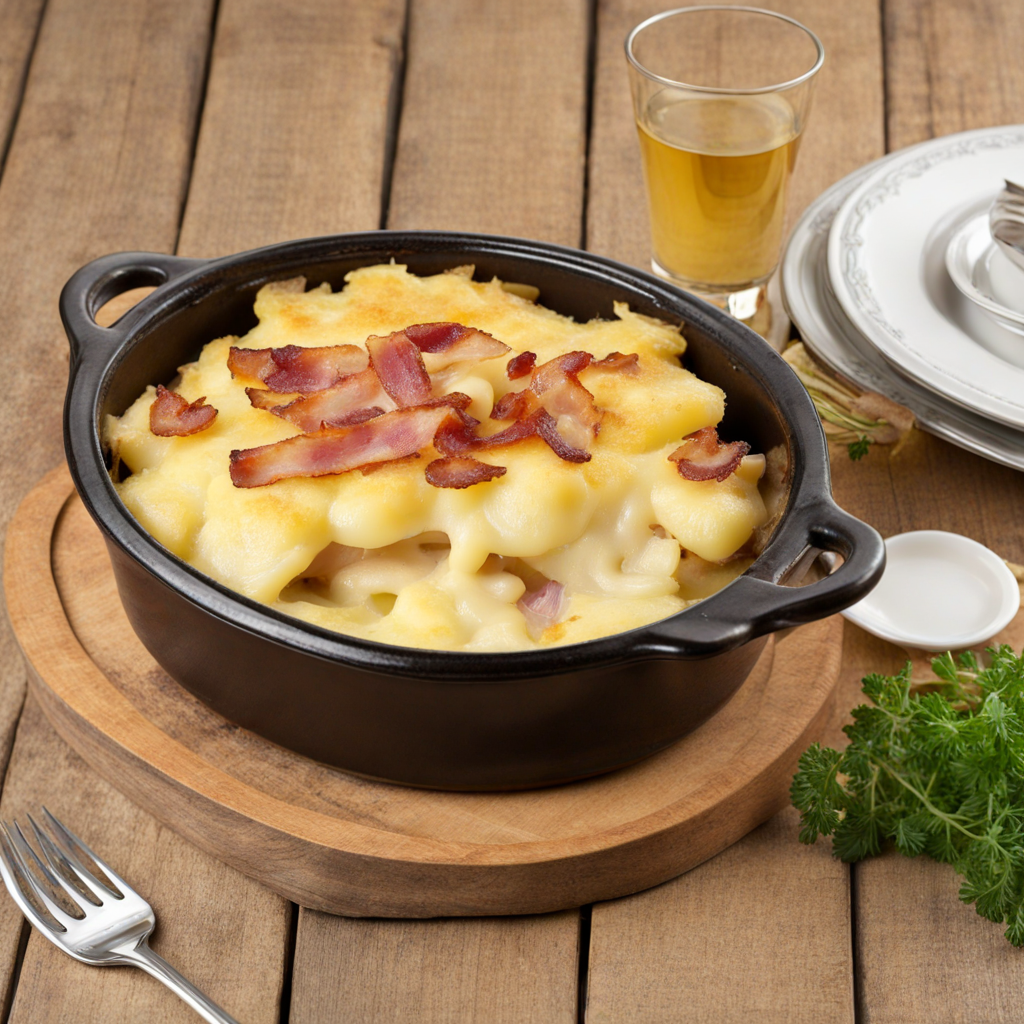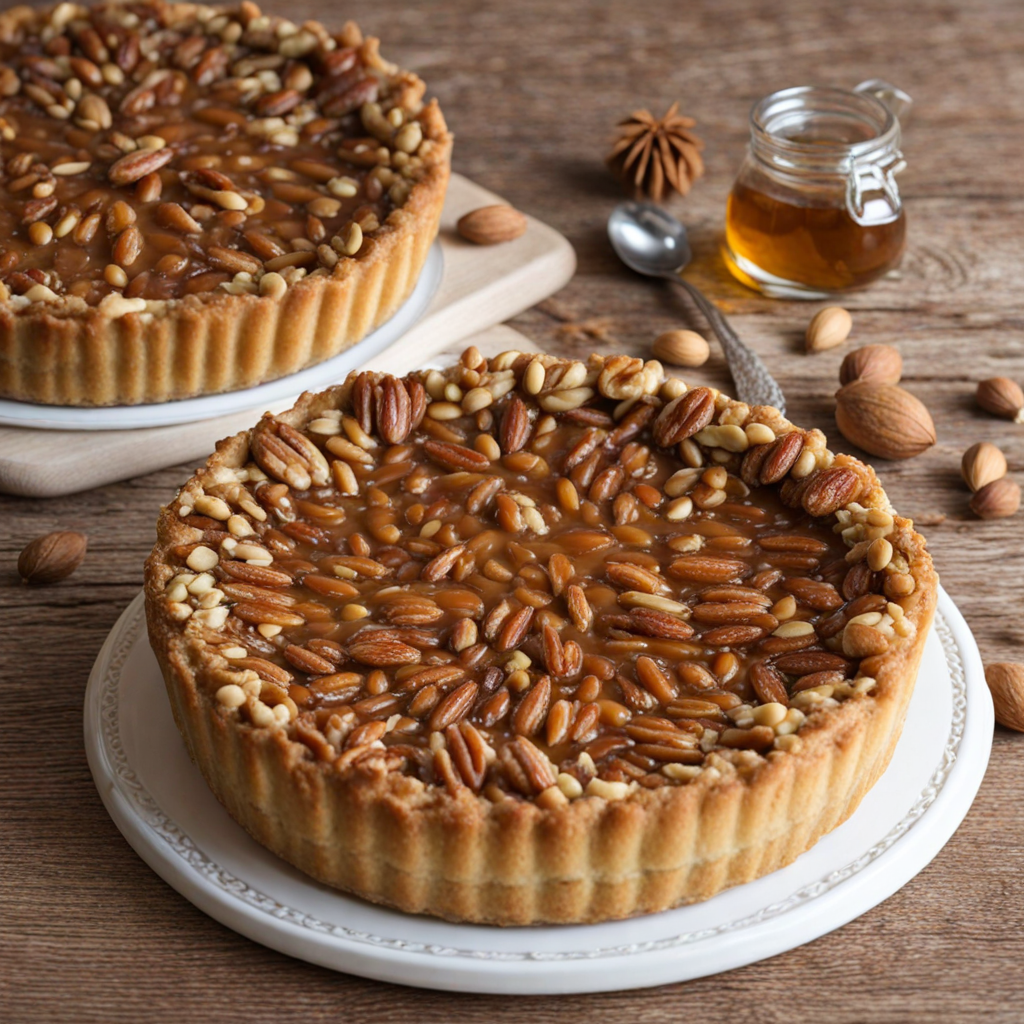Tartiflette
Tartiflette is a delectable Swiss dish that embodies the rich and hearty flavors of the Alpine region. This traditional recipe is primarily made with layers of creamy Reblochon cheese, which melts beautifully when baked, creating a luscious, gooey texture. The dish is complemented by the earthy taste of potatoes, which are typically boiled and then sliced before being layered with other ingredients. The combination of these components results in a comforting meal that warms the soul, perfect for chilly mountain evenings. In addition to the potatoes and Reblochon, Tartiflette features sautéed onions and smoky lardons (or pancetta), which add depth and a savory punch to the dish. The onions are often caramelized to bring out their natural sweetness, while the lardons contribute a delightful crispiness that contrasts beautifully with the softness of the potatoes and cheese. The dish is usually seasoned with a hint of white wine and black pepper, enhancing the overall flavor profile and making each bite a delightful experience. Served bubbling hot from the oven, Tartiflette is typically enjoyed family-style, allowing everyone to dig in and savor the rich, cheesy goodness together. This dish not only showcases the rustic ingredients of the Swiss landscape but also stands as a symbol of communal dining. Whether enjoyed après-ski or during a cozy gathering, Tartiflette invites you to experience the warmth and comfort of Swiss cuisine in every delicious bite.
How It Became This Dish
Tartiflette: A Culinary Journey Through the Alps Tartiflette is a beloved dish that epitomizes the cozy essence of alpine cuisine, often associated with the French region of Savoie. While many people mistakenly attribute its origins to Switzerland, the dish actually has roots deeply embedded in the French Alps. Its history is a fascinating tapestry woven with threads of local tradition, agricultural practices, and the evolution of alpine gastronomy. The Origins of Tartiflette The term "tartiflette" is derived from the Savoyard word "tartifla," which refers to potatoes. The dish is primarily made from potatoes, reblochon cheese, lardons (small strips of pork), and onions, baked together to create a rich, creamy casserole. Its origins can be traced back to the 18th century, although there are earlier incarnations of similar potato and cheese dishes in the Alps. Historically, potatoes were introduced to Europe in the late 16th century after being brought over from South America. Initially met with skepticism, they eventually gained popularity in the 18th century as a staple food in the mountainous regions of France and Switzerland. The harsh climate and rugged terrain of the Alps made potatoes an ideal crop, as they were hardy, nutritious, and could be stored for long periods. The use of cheese in alpine cooking dates back centuries, as local shepherds would produce cheese from the milk of their herds while tending to their flocks in the high pastures. Reblochon cheese, a soft, creamy cheese made from cow's milk, became particularly popular in the Savoie region. It is believed that tartiflette as we know it today began to take shape when these local agricultural products were combined into a single dish. Cultural Significance Tartiflette is more than just a dish; it embodies the spirit of alpine living. Traditionally consumed in the colder months, it provides sustenance and warmth for those who live in or visit the mountainous regions. The dish is often served in chalets and lodges, where skiers and hikers gather after a day in the snow, relishing in its hearty flavors. In Savoie, tartiflette is often associated with conviviality and the French concept of "terroir," which celebrates the connection between food and the land from which it comes. As with many regional dishes, tartiflette reflects the ingredients available in the region and the traditions of the people who prepare it. Sharing a tartiflette with friends and family is a cherished ritual that highlights the importance of community in alpine culture. The Development of Tartiflette Over Time While the early iterations of tartiflette may have been rustic and simple, the dish underwent a transformation in the late 20th century. The modern version of tartiflette was popularized in the 1980s as part of a marketing campaign by the French dairy industry aimed at promoting reblochon cheese. This campaign sought to elevate the dish from a humble mountain meal to a culinary staple that could be enjoyed beyond the alpine regions. As a result, tartiflette began to appear on menus in restaurants throughout France, especially in ski resorts and urban centers. Its creamy texture, hearty ingredients, and comforting flavors made it a favorite among diners seeking a taste of the Alps. The dish's rise in popularity also coincided with a broader movement in French cuisine that emphasized regional cooking and the revival of traditional dishes. In the years since, tartiflette has become synonymous with winter holidays and festive gatherings. It is frequently featured at Christmas markets and winter celebrations, delighting both locals and tourists alike. The dish's accessibility and simplicity have made it a popular choice for home cooks as well, inspiring countless variations and adaptations. Variations and Modern Interpretations While the classic tartiflette remains beloved, contemporary chefs and home cooks have embraced the dish's versatility, leading to a plethora of variations. Some may incorporate different types of cheese, such as Gruyère or Emmental, while others may experiment with the addition of ingredients like mushrooms, garlic, or even truffles. Vegetarian versions have also emerged, substituting the lardons with smoked tofu or other meat alternatives. Outside of France, tartiflette has made its way into international cuisine, with variations appearing in ski resorts across Europe and North America. It has been adapted to suit local tastes and ingredients, allowing it to resonate with a broader audience. In some cases, it has even inspired fusion dishes that blend elements of other culinary traditions with the classic alpine flavors. Tartiflette Today Today, tartiflette is a celebrated dish that reflects the richness of alpine culinary heritage. It has become a staple in both traditional mountain restaurants and modern bistros, offering diners a taste of the high-altitude lifestyle. Its presence on menus signals a desire for comfort food that warms both body and soul, especially during the chilly winter months. The dish is often accompanied by simple sides such as green salad, pickles, or crusty bread, allowing the flavors of the tartiflette to shine. Wine, particularly white wine from the Savoie region, is a popular pairing, enhancing the dining experience with its crisp acidity and floral notes. In recent years, the rise of social media has further fueled the popularity of tartiflette, as food enthusiasts share their culinary creations and experiences with the dish. The vibrant, cheesy, and inviting appearance of tartiflette has made it a favorite subject for food photography, showcasing its appeal to a global audience. Conclusion Tartiflette is a dish that tells the story of the alpine environment and the people who inhabit it. From its humble beginnings as a simple potato and cheese casserole to its status as a beloved comfort food, the journey of tartiflette reflects the evolution of culinary traditions in the face of changing times. As we continue to celebrate and adapt this classic dish, we honor the rich heritage of the Alps and the flavors that unite us in warmth and community. Whether enjoyed in a cozy mountain chalet or at home during the winter months, tartiflette remains a symbol of comfort, hospitality, and the enduring connection between food and culture.
You may like
Discover local flavors from Switzerland







